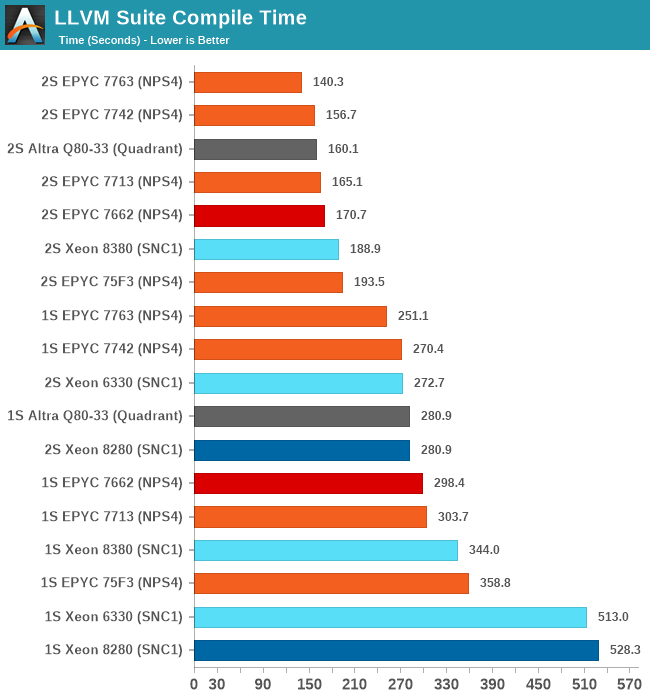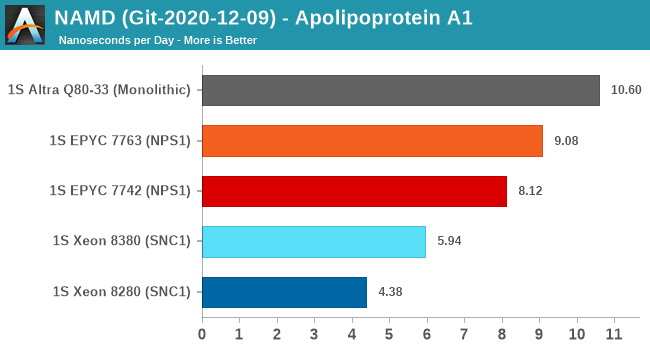Intel 3rd Gen Xeon Scalable (Ice Lake SP) Review: Generationally Big, Competitively Small
by Andrei Frumusanu on April 6, 2021 11:00 AM EST- Posted in
- Servers
- CPUs
- Intel
- Xeon
- Enterprise
- Xeon Scalable
- Ice Lake-SP
Compiling LLVM, NAMD Performance
As we’re trying to rebuild our server test suite piece by piece – and there’s still a lot of work go ahead to get a good representative “real world” set of workloads, one more highly desired benchmark amongst readers was a more realistic compilation suite. Chrome and LLVM codebases being the most requested, I landed on LLVM as it’s fairly easy to set up and straightforward.
git clone https://github.com/llvm/llvm-project.gitcd llvm-projectgit checkout release/11.xmkdir ./buildcd ..mkdir llvm-project-tmpfssudo mount -t tmpfs -o size=10G,mode=1777 tmpfs ./llvm-project-tmpfscp -r llvm-project/* llvm-project-tmpfscd ./llvm-project-tmpfs/buildcmake -G Ninja \ -DLLVM_ENABLE_PROJECTS="clang;libcxx;libcxxabi;lldb;compiler-rt;lld" \ -DCMAKE_BUILD_TYPE=Release ../llvmtime cmake --build .We’re using the LLVM 11.0.0 release as the build target version, and we’re compiling Clang, libc++abi, LLDB, Compiler-RT and LLD using GCC 10.2 (self-compiled). To avoid any concerns about I/O we’re building things on a ramdisk. We’re measuring the actual build time and don’t include the configuration phase as usually in the real world that doesn’t happen repeatedly.

Starting off with the Xeon 8380, we’re looking at large generational improvements for the new Ice Lake SP chip. A 33-35% improvement in compile time depending on whether we’re looking at 2S or 1S figures is enough to reposition Intel’s flagship CPU in the rankings by notable amounts, finally no longer lagging behind as drastically as some of the competition.
It’s definitely not sufficient to compete with AMD and Ampere, both showcasing figures that are still 25 and 15% ahead of the Xeon 8380.
The Xeon 6330 is falling in line with where we benchmarked it in previous tests, just slightly edging out the Xeon 8280 (6258R equivalent), meaning we’re seeing minor ISO-core ISO-power generational improvements (again I have to mention that the 6330 is half the price of a 6258R).

NAMD is a problem-child benchmark due to its recent addition of AVX512: the code had been contributed by Intel engineers – which isn’t exactly an issue in my view. The problem is that this is a new algorithm which has no relation to the normal code-path, which remains not as hand-optimised for AVX2, and further eyebrow raising is that it’s solely compatible with Intel’s ICC and no other compiler. That’s one level too much in terms of questionable status as a benchmark: are we benchmarking it as a general HPC-representative workload, or are we benchmarking it solely for the sake of NAMD and only NAMD performance?
We understand Intel is putting a lot of focus on these kinds of workloads that are hyper-optimised to run well extremely on Intel-only hardware, and it’s a valid optimisation path for many use-cases. I’m just questioning how representative it is of the wider market and workloads.
In any case, the GCC binaries of the test on the ApoA1 protein showcase significant performance uplifts for the Xeon 8380, showcasing a +35.6% gain. Using this apples-to-apples code path, it’s still quite behind the competition which scales the performance much higher thanks to more cores.










169 Comments
View All Comments
Drazick - Wednesday, April 7, 2021 - link
The ICC compiler has much better vectorization engine than the one in GCC. It will usually generate better vectorized code. Especially numerical code.But the real benefit of ICC is its companion libraries: VSML, MKL, IPP.
Oxford Guy - Wednesday, April 7, 2021 - link
I remember that custom builds of Blender done with ICC scored better on Piledriver as well as on Intel hardware. So, even an architecture that was very different was faster with ICC.mode_13h - Thursday, April 8, 2021 - link
And when was this? Like 10 years ago? How do we know the point is still relevant?Oxford Guy - Sunday, April 11, 2021 - link
How do we know it isn't?Instead of whinge why not investigate the issue if you're actually interested?
Bottom line is that, just before the time of Zen's release, I tested three builds of Blender done with ICC and all were faster on both Intel and Piledriver (a very different architecture from Haswell).
I asked why the Blender team wasn't releasing its builds with ICC since performance was being left on the table but only heard vague suggestions about code stability.
Wilco1 - Sunday, April 11, 2021 - link
This thread has a similar comment about quality and support in ICC: https://twitter.com/andreif7/status/13808945639975...KurtL - Wednesday, April 7, 2021 - link
This is absolutely untrue. There is not much special about AOCC, it is just a AMD-packaged Clang/LLVM with few extras so it is not a SPEC compiler at all. Neither is it true for Intel. Sites that are concerned about getting the most performance out of their investments often use the Intel compilers. It is a very good compiler for any code with good potential for vectorization, and I have seen it do miracles on badly written code that no version of GCC could do.Wilco1 - Wednesday, April 7, 2021 - link
And those closed-source "extras" in AOCC magically improve the SPEC score compared to standard LLVM. How is it not a SPEC compiler just like ICC has been for decades?JoeDuarte - Wednesday, April 7, 2021 - link
It's strange to tell people who use the Intel compiler that it's not used much in the real world, as though that carries some substantive point.The Intel compiler has always been better than gcc in terms of the performance of compiled code. You asserted that that is no longer true, but I'm not clear on what evidence you're basing that on. ICC is moving to clang and LLVM, so we'll see what happens there. clang and gcc appear to be a wash at this point.
It's true that lots of open source Linux-world projects use gcc, but I wouldn't know the percentage. Those projects tend to be lazy or untrained when it comes to optimization. They hardly use any compiler flags relevant to performance, like those stipulating modern CPU baselines, or link time optimization / whole program optimization. Nor do they exploit SIMD and vectorization much, or PGO, or parallelization. So they leave a lot of performance on the table. More rigorous environments like HPC or just performance-aware teams are more likely to use ICC or at least lots of good flags and testing.
And yes, I would definitely support using optimized assembly in benchmarks, especially if it surfaced significant differences in CPU performance. And probably, if the workload was realistic or broadly applicable. Anything that's going to execute thousands, millions, or billions of times is worth optimizing. Inner loops are a common focus, so I don't know what you're objecting to there. Benchmarks should be about realizable optimal performance, and optimization in general should be a much bigger priority for serious software developers – today's software and OSes are absurdly slow, and in many cases desktop applications are slower in user-time than their late 1980s counterparts. Servers are also far too slow to do simple things like parse an HTTP request header.
pSupaNova - Wednesday, April 7, 2021 - link
"today's software and OSes are absurdly slow, and in many cases desktop applications are slower in user-time than their late 1980s counterparts." a late 1980's desktop could not even play a video let alone edit one, your average mid range smartphone is much more capable. My four year old can do basic computing with just her voice. People like you forget how far software and hardware has come.GeoffreyA - Wednesday, April 7, 2021 - link
Sure, computers and devices are far more capable these days, from a hardware point of view, but applications, relying too much on GUI frameworks and modern languages, are more sluggish today than, say, a bare Win32 application of yore.